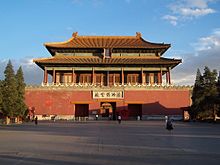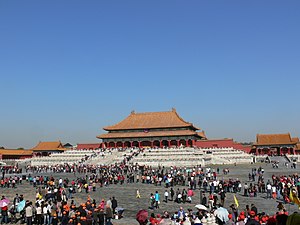Palace museum

The Gate of Divine Might, the northern gate. The lower tablet reads "The Palace Museum" (故宫博物院)
|
|
| Established | 1922 |
|---|---|
| Location | 4 Jingshan Front St, Dongcheng, Beijing,China |
| Coordinates | 39°54′58″N 116°23′53″E / 39.915987°N 116.397925°E |
| Type | Art museum, Imperial Palace, Historic site |
| Visitors | 14 million Ranking 1st globally |
| Curator | Shan Jixiang (单霁翔) |
| Built | 1406–1420 |
| Architect | Kuai Xiang (蒯祥) |
| Architectural style(s) | Chinese architecture |
| Website | www |
| Forbidden City | |||||||||||||||||||||
|
"Forbidden City" in Chinese characters
|
|||||||||||||||||||||
| Chinese | 紫禁城 | ||||||||||||||||||||
|---|---|---|---|---|---|---|---|---|---|---|---|---|---|---|---|---|---|---|---|---|---|
| Literal meaning | "Purple [North Star] Forbidden City" | ||||||||||||||||||||
|
|||||||||||||||||||||
| Transcriptions | |
|---|---|
| Standard Mandarin | |
| Hanyu Pinyin | Zǐjinchéng |
| IPA | [tsɨ̀.tɕîn.ʈʂʰə̌ŋ] |
| Yue: Cantonese | |
| Yale Romanization | Jí-gam-sìhng |
| Jyutping | Zi2-gam3-sing4 |
| Southern Min | |
| Hokkien POJ | Chí-kìm-siâⁿ |
| Tâi-lô | Tsí-kìm-siânn |
| Imperial Palaces of the Ming and Qing Dynasties in Beijing and Shenyang | |
|---|---|
| Name as inscribed on the World Heritage List | |
 |
|
| Location | China |
| Type | Cultural |
| Criteria | i, ii, iii, iv |
| Reference | 439 |
| UNESCO region | Asia-Pacific |
| Inscription history | |
| Inscription | 1987 (11th Session) |
| Extensions | 2004 |
The Forbidden City was the Chinese imperial palace from the Ming dynasty to the end of the Qing dynasty—the years 1420 to 1912. It is located in the centre of Beijing, China, and now houses the Palace Museum. It served as the home of emperors and their households as well as the ceremonial and political centre of Chinese government for almost 500 years.
Constructed from 1406 to 1420, the complex consists of 980 buildings and covers 72 ha (over 180 acres). The palace complex exemplifies traditional Chinese palatial architecture, and has influenced cultural and architectural developments in East Asia and elsewhere. The Forbidden City was declared a World Heritage Site in 1987, and is listed by UNESCO as the largest collection of preserved ancient wooden structures in the world.
Since 1925, the Forbidden City has been under the charge of the Palace Museum, whose extensive collection of artwork and artifacts were built upon the imperial collections of the Ming and Qing dynasties. Part of the museum's former collection is now located in the National Palace Museum in Taipei. Both museums descend from the same institution, but were split after the Chinese Civil War. With over 14.6 million annual visitors, the Palace Museum is the most visited art museum in the world.
The common English name, "the Forbidden City", is a translation of the Chinese name Zijin Cheng (Chinese: ; pinyin: Zíjinchéng; literally: "Forbidden City"). The name Zijin Cheng first formally appeared in 1576. Another English name of similar origin is "Forbidden Palace".
...
Wikipedia

